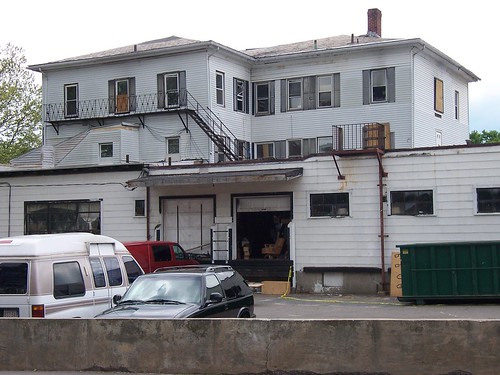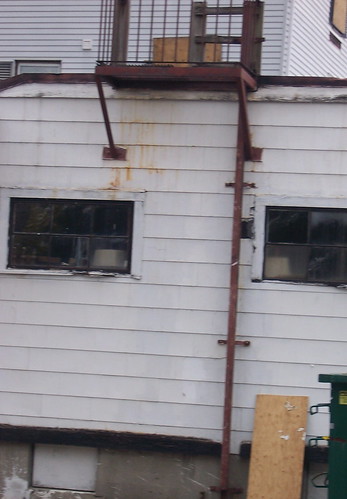Mike Kirby, former city councilor, has just published another great article on Kirby on the Loose. He fills in the larger story behind the recent fire at 11 Bridge Street, and we are reprinting it here with his kind permission:
 When
When
all is said and done, we were very lucky with the recent fire that tore
through Augie’s rooming house on Bridge Street. The luckiest people, I
guess, were the twenty-one residents that escaped alive when an alert
patrol officer spotted smoke boiling out of the third floor windows.
Within a few minutes all the fire engines and fire people in the world
converged on the location, along with the mayor, the building
inspector, and all the people from Red Cross. “It was a good stop,”
said the fire prevention officer to me, in that dry understated way
that professionals like commercial air pilots use to talk about their
work. Adrenalin and boredom say the stand-by people of the world,
talking later about events as if it was nothing all to rush into dense
smoke and go from room to room, finding people, getting them up and
out, finding and fighting the fire in a tinder-box place like Augies,
where no one in their right mind would let people live, unless it was
people that you didn’t care about very much. Augie’s was almost the
last of a dying breed, the flop house. Augie had a big heart, as Fred Contrada’s moving article in the Union points out.
Augie Woicekoski would rent to almost
anyone. He’d rent to alcoholics and drug addicts and guys with felony
convictions whose record meant they couldn’t get a room in any of the
subsidized places that did CORI checks. But he’d also rent to people
who were just down on their luck temporarily. I’ve stayed in flop
houses as a kid. They got you off the street, but put you in bad
company. Dirty old men loved the dormitories in 1956-era cities.
Who’s really lucky, however, is the
Mayor, who once again dodged the bullet for her policy of not dealing
with housing violations in our rooming houses. Peg Keller, the Mayor’s
housing assistant, met with me the other morning to talk about Augie’s.
She was wary and a bit distant. Maybe she guessed what I was going to
say in my article, that she and the Mayor, despite all their heroic and
selfless efforts to mobilize the resources of the community to help the
displaced people, bore a big share of the responsibility for this
little disaster. They should have seen it coming.
ma*****@*****on.net, on Flickr”>
A Fire Escape used to be Here
I don’t know the history of the
building. It has the look of being an old hotel that had a storefront
grafted onto it at one time or another. Today it is an antique store
run by members of Augie’s family. Augie does his numismatics and
rooming house business out of the basement. He has a permit to run a
rooming house from the license commission, so it’s not like he is
operating under the radar. Indeed, he is (or was) operating a public
utility of sorts. After the Mayor talked with the whole family the day
after the fire, she brought him down to meet all the people from
different agencies who were meeting to figure out what needed to be
done for the displaced people. They all gave him a big round of
applause. Augie has a big heart, and I guess a lot of social workers
and probation officers in this town are grateful that he and his
building are there. Ah, but if one of my people were in Augie’s I might
sigh with relief, but I’d be working the next day to get him the hell
out of that place into some place that was quieter and saner and safer.
Because Augie Woicekoski is 87 years old and as stubborn as a mule. A
Northampton cop, now retired, tried to get him to outsource his
screening to someone who knew what he was doing, but he fought off that
well-intentioned buttinski.
If you stand in the parking lot behind
the building and look at it, like I did last night, you saw a nice
sunset behind it. It could be a painting, perhaps, by a Northampton
realist: Augie’s at sunset. Now you can see, in a few places, the brick
patterned paper behind the plastic siding. You will also see, as my
friend did, that there is no working fire escape for the building.
There is a fire escape on the third floor, but it would dump people on
the roof. There used to be a fire escape ladder down from the roof to
the parking lot, but I guess Augie might have dismantled it because of
too many unauthorized exits or entrances.
The luck that we all had worked
at a lot of levels: The fire didn’t get into the attic, because the
building didn’t have any fire stops in the wall. The lack of fire stops
turns every space between building studs into a potential chimney that
vents into the attic. Bone-dry pine, enormous drafts, buildings burning
to the ground. People hanging out the windows screaming. The building
inspector had been in the building in December, there had been, I think
a recent fire inspection. Between the inspection and the time of the
fire, the batteries on six smoke alarms were removed. People smoking in
their rooms evidently pulled the batteries out.
So this is probably it, for Augie’s. The
building inspector will demand sprinklers if it is to reopen. When Tony
Patillo got into the attic, he discovered sagging floors and a jungle
of 2” x 3” braces holding up the roof, some of which were charred from
a previous fire and never replaced. In his letter to Augie (see this)
he specifies a lot of work that has to be accomplished before the
building can re-open. This closure order also covers the shops on the
basement and first floor.
Privately owned rooming houses once
flourished in Northampton; now there are only two left, to my
knowledge. 129 Pleasant, which is for sale, and Shaws. The city and
social service agencies, especially veterans groups supported places
like Augies because they were housing of last resort: where people who
were drinking or drugging or had a record could live. But this informal
policy had a price, and that price was paid by the troops, fire and
police, who put out fires and broke up fights, and the people who lived
in these places, who had to put up with a degree of chaos. Would-be
novelists might have loved Augies.
Peg Keller told me straight out
that the city needed places like Augies that would shelter people that
were using or drinking: this policy cannot be done on the cheap.
Rooming houses cannot be firetraps. Looking the other way and failing
to enforce housing and public health regulations at Augies had a heavy
cost, and people could have died. Someone who was there said it was a
miracle no one died. It put a substantial burden on the Red Cross. All
of a sudden these social service and housing organizations had to deal
with and place 21 people, most of whom had tough addiction, life style
and legal problems that made placement difficult. A shelter that had
closed for the summer had to be reopened. Mary Snyders of the Red
Cross, who handled a lot of the relocations and too many fire crises
lately, collapsed with chest pains and got taken off to Cooley
Dickinson. I think she is ok, but she isn’t back at work yet. As of
this press date (Wednesday, May 21) most of Augie’s tenants now have
places to live. A couple people, though, just disappeared; most are in
SROs and public housing units; two non-veterans are being temporarily
housed up at the shelter at the VA (Soldier On). The City of
Northampton has an obligation to assist people find housing, but it has
an equally important obligation to ensure that Northampton’s housing is
safe. Tenants have a right to “peaceful enjoyment” of their premises.
The city’s policy is a classic double standard, done with all the good
intentions in the world.
See also: